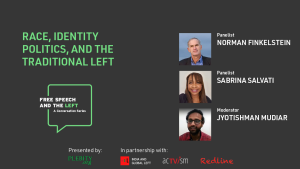Thank you, Sasha, for having offered me this valuable opportunity to answer these questions. Before we start, I would like to clarify my stance on basic issues regarding sex and gender identity, so that people can keep these in mind while reading.
 Biological sex is not a social construct – male and female are distinct material realities which have significant implications for medical and surgical treatment of many different conditions. These physiological differences are relevant on the levels of clinical practice, research, and policy, and absolutely must be acknowledged in order for physicians to best treat their patients. All patients should be treated with compassion, respect, and high-quality medical care, regardless of their professed gender identity. I remain agnostic as to what it truly means to have a “gender identity”, but will respect the wishes of my future patients in regards to their social presentation and pronouns. I believe that dysphoric adults should be able to pursue transition. Physicians should be aware of relevant aspects of trans healthcare, including hormone therapy and surgery, so that they can better advise trans patients on how medical treatments may impact their gender-related care, or vice versa. It is possible and desirable for us to have a healthcare system which is inclusive and respectful of transgender patients, in a way which does not pretend that biology is arbitrary or merely a social construct. Despite my liberal beliefs, the loudest voices at my institution would falsely accuse me of blowing transphobic dog-whistles, hence my anonymity. This hostile climate is corrosive to an inquiry mindset and critical thinking, and will ultimately be a disservice to the scientific community and to future patients, trans and otherwise.
Biological sex is not a social construct – male and female are distinct material realities which have significant implications for medical and surgical treatment of many different conditions. These physiological differences are relevant on the levels of clinical practice, research, and policy, and absolutely must be acknowledged in order for physicians to best treat their patients. All patients should be treated with compassion, respect, and high-quality medical care, regardless of their professed gender identity. I remain agnostic as to what it truly means to have a “gender identity”, but will respect the wishes of my future patients in regards to their social presentation and pronouns. I believe that dysphoric adults should be able to pursue transition. Physicians should be aware of relevant aspects of trans healthcare, including hormone therapy and surgery, so that they can better advise trans patients on how medical treatments may impact their gender-related care, or vice versa. It is possible and desirable for us to have a healthcare system which is inclusive and respectful of transgender patients, in a way which does not pretend that biology is arbitrary or merely a social construct. Despite my liberal beliefs, the loudest voices at my institution would falsely accuse me of blowing transphobic dog-whistles, hence my anonymity. This hostile climate is corrosive to an inquiry mindset and critical thinking, and will ultimately be a disservice to the scientific community and to future patients, trans and otherwise.
IDD64 @IDD64 asks: “What happened to “nobody’s saying sex isn’t real”?”
This is actually what compelled me to speak out about this practice in the first place. Well-intentioned non-medical people often assume that medical schools are teaching something like, “Gender identity can be fluid and varied, but biological sex is real, binary, and relevant in medical contexts.” This idea is around five years out of date in the most progressive of institutions. I have been told multiple times in several classes that biological sex is a social construct – not just gender. Granted, I can speak only for my institution, but this change has been frustrating and disturbing to witness.
Robert Woolley @RandomlyBob asks: “Do any of the required textbooks also avoid using those words? If not, might you ask those professors if they think the books are either inaccurate or offensive?”
Our curriculum is constantly subject to revision. Around two-thirds of our written materials have been updated with this new language. For the one-third that has remained out-of-date, our class has received multiple apologetic, itemized emails from course instructors in which they provide corrections, beg for forgiveness and patience, and avow to “do better”. In class, we have been given multiple histories in which the patient’s sex has been deleted, even for cases involving disorders which can manifest differently between the sexes. The words “female” and “male” are being erased and replaced.
Born a space baby @ggynoid asks: “What’s the dynamic like for class participation? Do people start with pronouns? Do people tend to agree, disagree? What’s the female-male ratio in the class typically on these sort[s] of classes?”
When school first began, we were heavily encouraged to include pronouns in our Zoom names and email signatures; around 70-80% of the class did so. Most students and professors would start off verbal introductions with their name and pronouns, though that has subsided since we all have grown to know each other.
A vocal minority of students are loudly in favor of the most extreme aspects of gender ideology, while the majority seem to be vaguely supportive in a nonspecific way. I think that this comes from a mixture of naive goodwill and fear – they are trying to be good allies, and this is the only way they know how. Additionally, it is heavily implied that to ask critical questions, even in a way which is ultimately patient-centered and supportive, is perpetuating bigotry, so they just nod along. A silent minority seems to be secretly skeptical. I have met four or five students who have disclosed to me in private conversation that they disagree with one or more aspects of this dogma but they are hesitant to come forward in group settings. I am sure that more exist, but they are hard to find. None of these people have been transphobic.
The female-male ratio is approximately equal, with slightly more females than males in my class.
David Poole @MrDPoole asks: “Do you think the people telling you these things actually believe it or are they being forced to do it?”
I think that a very small minority of our professors actually believe that male and female bodies are interchangeable with the exception of genitalia and gonads. There are definitely more woke students than woke professors, and the most radical of students are far more radical than the wokest professor. Most of these professors are very fearful of saying the wrong thing, so they delicately couch their language by referring to “XX and XY people” or other such euphemisms, even though that can lead to inaccuracies.
The social consequences for misspeaking are highly magnified, especially when most classes are delivered online (due to the pandemic). Our class has been quietly accused of having a mean streak in regards to social justice. We have had petitions circulated (drafted by few, signed by many) to name, shame, and “hold accountable” various lecturers who used the “wrong” language, to the point of humiliation. One professor broke down crying after a genetics lecture which relied heavily on the use of “male” and “female” by necessity. (Though the lecture also made ample space to talk about transgender and non-binary individuals, this was not enough to appease the critics.) Another professor referred to “pregnant women” rather than “pregnant people” and spent a very uncomfortable few minutes after class abjectly apologizing for having caused offense “by implying that only women can get pregnant”. It was incredibly disturbing to see, for multiple reasons. One, this is based on bad science and zealotry that has the potential to harm patients. Two, the magnitude of the “crime” pales in comparison to the magnitude of the outcry. Three, it is a total inversion of the expected social order to see these physicians —some of whom are literally leading scholars in their field— be reduced to fearful puddles if a student so much as looks at them askance. Keep in mind that these professors are extremely liberal, compassionate, and well-meaning, yet they are turned upon with such venom and verve by the people who they are trying to please.
Chopper @RodeoChopper asks: How are cases presented? Normally the first line is “This is a such and such year old (male/female) with a past medical history significant for…”
Here are some examples of formats I have seen in our coursework:
“This is a 43-year-old woman with ovaries, presenting with …”
“A 3-year-old child, assigned male at birth, not assigned gender as of yet by parents, presenting with …”
“This patient is a 7-year-old child, gendered as a boy by his parents, who …”
“57-year-old woman with testes, here with …”
“A 16-year-old patient (gender non-binary, pronouns they/them) …”
“A 32-year-old woman (she/her/hers) …”
“A 16-year-old patient presents with complaints of …”
Of the myriad problems with this structure, the most concerning is that most of these cases do not accurately identify the sex of the patient, which is crucial in being able to weigh the likelihood of potential diagnoses and treatments. A person’s pronouns are not relevant when deciding to prescribe a particular antibiotic, and at which dose. Additionally, I find it somewhat irritating to be expected to state the obvious for things that are the default of the human experience. We do not say, “This is a 42-year-old woman with both her arms and legs”, although there are certainly women in this world who are missing one or more of their limbs.
MaryWrath @WrathMary asks: “So how are reproductively different bodies described then? How are cardiac arrest and stroke symptoms described, explained and taught as we know now they present differently across the two sexes? There are clearly two bodies in our species so how are the professors acknowledging?”
Organs are referred to by their actual names – penis, testes, vagina, ovaries, breasts. However, referring to patients as male or female is strictly taboo. If there are relevant but subtle sex-specific differences, then they will often be downplayed or ignored altogether. As an example, we were told that the higher risk of heart attacks in men was due only to the presence of testosterone, and not for any other reason, which is patently false. When the differences are utterly impossible to ignore, “male” and “female” will simply be rebranded as “people with testes/ovaries”, “AMAB/AFAB”, or “people with/without Y chromosomes”. My personal favorite is “persons with [testosterone/estrogen] as their primary sex hormone.” Oddly, “man” and “woman” are still used, often with redundant qualifiers (“56-year-old man with testes”).
thames pilgrim @thames_pilgrim asks: “What are the most dangerous medical implications for turning a blind eye to someone’s sex due to a belief that talking about “male” and “female” might offend?”
This is a very important question which should be addressed at the following interrelated levels: clinical practice, research, and public policy.
Clinical practice: Transgender patients who do not disclose their birth sex might be at risk for improper medical treatment. (I have seen a natal female person who identified as a nonbinary man, be suspected of having testicular torsion; this person did not disclose their sex to the physician, which resulted in a delay in their care). Out of fear of being branded transphobic, physicians may not accurately and completely inform trans patients about their sex-specific risk for certain medical conditions. And for all patients, if a poorly-educated doctor is unaware as to how disorders manifest differently between the sexes, then patients can be harmed through the failure to rapidly and accurately diagnose and treat their medical conditions.
Research: Bad data generates bad research; bad research generates bad treatments; bad treatments generate bad outcomes. The physiological differences between males and females are vast, and stamp their mark on every organ of the human body, not just the genitals and gonads. Ignoring these differences will muddle our data, blur our understanding of physiology, and hinder the discovery of new treatments for diseases. Females are much more likely than males to have autoimmune disorders. Males are more likely than females to develop Parkinson’s disease. Males and females may present with different symptoms preceding a heart attack. Males and females metabolize drugs differently. Blatantly ignoring sex as a variable hobbles the process of scientific inquiry and limits the types of questions that researchers will ask, thereby limiting the answers they get.
Policy: Patients who are not transgender may be misled by “inclusive” educational materials and miss out on crucial preventative care. This is especially impactful in women’s health; whether due to language barrier, subpar sex education, or cultural taboo, not every woman will even know that she has a cervix, but she will know that she is female. Additionally, recommendations made by professional medical associations are widely used in clinical practice; if these guidelines are generated based on faulty data, this could negatively impact patients on a wider scale.
However, the most pernicious of possible harms is not the denial of sex; rather, the denial of sex is just one manifestation of a greater problem, which is the corrosion of critical thinking itself. Whatever you call it – this postmodern poison, the triumph of dogma over data – it is fundamentally incompatible with critical thinking, the most powerful all-purpose tool a physician has at his or her disposal. Starting with a conclusion and working backwards, all while twisting the data to fit a narrative, strikes me as more religious than scientific.
Marjorie Hutchins @leakylike asks: “Part of being a doctor is taking on ethical & safeguarding responsibilities[.] Why aren’t medical students challenging something which [could] have health implications for patients?”
Our positions as students are precarious, especially if one is labeled as being on the wrong side of history. Consequences for speaking out can include shunning, being anonymously reported to the school for “remediation”, being informally blacklisted from research and leadership opportunities, and potentially expulsion. Until I have earned my degree and have completed residency, I need to remain anonymous. To do otherwise would be to kill my career before it has even begun, which would also limit my ability to help many more patients in the future.
Although I am very biased, I think it should be on the onus of administration and our tenured professors to stand up against this madness, rather than on lone students to publicly put themselves at risk of debt and ruin. For now, I resist in the small ways that I can; I wish to do so more publicly when I am more secure.



